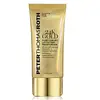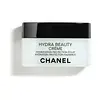What's inside
What's inside
 Key Ingredients
Key Ingredients

 Benefits
Benefits

 Concerns
Concerns

 Ingredients Side-by-side
Ingredients Side-by-side

Water
Skin ConditioningGlycerin
HumectantMica
Cosmetic ColorantHydrogenated Polyisobutene
EmollientHomosalate
Skin ConditioningPropanediol
SolventEthylhexyl Methoxycinnamate
UV AbsorberOctyldodecanol
EmollientTrilaureth-4 Phosphate
EmulsifyingGlyceryl Stearate
EmollientJojoba Esters
EmollientCetyl Alcohol
EmollientCeteareth-12
EmulsifyingCeteareth-20
CleansingColloidal Gold
AntimicrobialSodium Hyaluronate
HumectantTocopherol
AntioxidantAloe Barbadensis Leaf Juice
Skin ConditioningBHT
AntioxidantPersea Gratissima Oil
Skin ConditioningDimethicone
EmollientPentaerythrityl Tetraethylhexanoate
EmollientHamamelis Virginiana Water
AstringentCarbomer
Emulsion StabilisingCitric Acid
BufferingBoron Nitride
AbsorbentHdi/Trimethylol Hexyllactone Crosspolymer
Tin Oxide
AbrasiveSilica Dimethyl Silylate
EmollientTriethanolamine
BufferingSilica
AbrasivePolyester-1
Benzoic Acid
MaskingPentylene Glycol
Skin ConditioningPotassium Sorbate
PreservativeSodium Benzoate
MaskingPhenoxyethanol
PreservativeCI 77480
Cosmetic ColorantCI 77891
Cosmetic ColorantCI 75470
Cosmetic ColorantIron Oxides
Water, Glycerin, Mica, Hydrogenated Polyisobutene, Homosalate, Propanediol, Ethylhexyl Methoxycinnamate, Octyldodecanol, Trilaureth-4 Phosphate, Glyceryl Stearate, Jojoba Esters, Cetyl Alcohol, Ceteareth-12, Ceteareth-20, Colloidal Gold, Sodium Hyaluronate, Tocopherol, Aloe Barbadensis Leaf Juice, BHT, Persea Gratissima Oil, Dimethicone, Pentaerythrityl Tetraethylhexanoate, Hamamelis Virginiana Water, Carbomer, Citric Acid, Boron Nitride, Hdi/Trimethylol Hexyllactone Crosspolymer, Tin Oxide, Silica Dimethyl Silylate, Triethanolamine, Silica, Polyester-1, Benzoic Acid, Pentylene Glycol, Potassium Sorbate, Sodium Benzoate, Phenoxyethanol, CI 77480, CI 77891, CI 75470, Iron Oxides
Water
Skin ConditioningGlycerin
HumectantOctyldodecyl Neopentanoate
EmollientHydrogenated Polyisobutene
EmollientSilica
AbrasiveC12-15 Alkyl Benzoate
AntimicrobialPentylene Glycol
Skin ConditioningOctyldodecanol
EmollientPEG-40 Stearate
EmulsifyingCamellia Kissi Seed Oil
EmollientGlyceryl Stearate
EmollientAmmonium Acryloyldimethyltaurate/Vp Copolymer
Zingiber Officinale Root Extract
MaskingCamellia Japonica Flower Extract
EmollientButyrospermum Parkii Butter
Skin ConditioningPhytosteryl Canola Glycerides
Skin ConditioningPhenoxyethanol
PreservativeSaccharide Isomerate
HumectantCetyl Alcohol
EmollientSteareth-2
EmulsifyingDimethicone
EmollientParfum
MaskingCaprylyl Glycol
EmollientSodium Carbomer
Emulsion StabilisingLauroyl Lysine
Skin ConditioningPropylene Glycol
HumectantPEG-12
HumectantPentaerythrityl Tetra-Di-T-Butyl Hydroxyhydrocinnamate
AntioxidantSodium Hyaluronate
HumectantSodium Citrate
BufferingPhytic Acid
Citric Acid
BufferingTocopherol
AntioxidantAscorbyl Palmitate
AntioxidantSodium Benzoate
MaskingWater, Glycerin, Octyldodecyl Neopentanoate, Hydrogenated Polyisobutene, Silica, C12-15 Alkyl Benzoate, Pentylene Glycol, Octyldodecanol, PEG-40 Stearate, Camellia Kissi Seed Oil, Glyceryl Stearate, Ammonium Acryloyldimethyltaurate/Vp Copolymer, Zingiber Officinale Root Extract, Camellia Japonica Flower Extract, Butyrospermum Parkii Butter, Phytosteryl Canola Glycerides, Phenoxyethanol, Saccharide Isomerate, Cetyl Alcohol, Steareth-2, Dimethicone, Parfum, Caprylyl Glycol, Sodium Carbomer, Lauroyl Lysine, Propylene Glycol, PEG-12, Pentaerythrityl Tetra-Di-T-Butyl Hydroxyhydrocinnamate, Sodium Hyaluronate, Sodium Citrate, Phytic Acid, Citric Acid, Tocopherol, Ascorbyl Palmitate, Sodium Benzoate
Ingredients Explained
These ingredients are found in both products.
Ingredients higher up in an ingredient list are typically present in a larger amount.
Cetyl Alcohol is a fatty alcohol. Fatty Alcohols are most often used as an emollient or to thicken a product.
Its main roles are:
Though it has "alcohol" in the name, it is not related to denatured alcohol or ethyl alcohol.
The FDA allows products labeled "alcohol-free" to have fatty alcohols.
Learn more about Cetyl AlcoholCitric Acid is an alpha hydroxy acid (AHA) naturally found in citrus fruits like oranges, lemons, and limes.
Like other AHAs, citric acid can exfoliate skin by breaking down the bonds that hold dead skin cells together. This helps reveal smoother and brighter skin underneath.
However, this exfoliating effect only happens at high concentrations (20%) which can be hard to find in cosmetic products.
Due to this, citric acid is usually included in small amounts as a pH adjuster. This helps keep products slightly more acidic and compatible with skin's natural pH.
In skincare formulas, citric acid can:
While it can provide some skin benefits, research shows lactic acid and glycolic acid are generally more effective and less irritating exfoliants.
Most citric acid used in skincare today is made by fermenting sugars (usually from molasses). This synthetic version is identical to the natural citrus form but easier to stabilize and use in formulations.
Read more about some other popular AHA's here:
Learn more about Citric AcidDimethicone is a type of synthetic silicone created from natural materials such as quartz.
What it does:
Dimethicone comes in different viscosities:
Depending on the viscosity, dimethicone has different properties.
Ingredients lists don't always show which type is used, so we recommend reaching out to the brand if you have questions about the viscosity.
This ingredient is unlikely to cause irritation because it does not get absorbed into skin. However, people with silicone allergies should be careful about using this ingredient.
Note: Dimethicone may contribute to pilling. This is because it is not oil or water soluble, so pilling may occur when layered with products. When mixed with heavy oils in a formula, the outcome is also quite greasy.
Learn more about DimethiconeGlycerin is already naturally found in your skin. It helps moisturize and protect your skin.
A study from 2016 found glycerin to be more effective as a humectant than AHAs and hyaluronic acid.
As a humectant, it helps the skin stay hydrated by pulling moisture to your skin. The low molecular weight of glycerin allows it to pull moisture into the deeper layers of your skin.
Hydrated skin improves your skin barrier; Your skin barrier helps protect against irritants and bacteria.
Glycerin has also been found to have antimicrobial and antiviral properties. Due to these properties, glycerin is often used in wound and burn treatments.
In cosmetics, glycerin is usually derived from plants such as soybean or palm. However, it can also be sourced from animals, such as tallow or animal fat.
This ingredient is organic, colorless, odorless, and non-toxic.
Glycerin is the name for this ingredient in American English. British English uses Glycerol/Glycerine.
Learn more about GlycerinGlyceryl Stearate is a mix of glycerin and stearic acid.
It is used to stabilize the mixing of water and oil ingredients. By preventing these ingredients from separating, it can help elongate shelf life. It can also help thicken the product's texture.
As an emollient, it helps soften skin and supports barrier-replenishing ingredients.
In cosmetics, Glyceryl Stearate is often made from vegetable oils or synthetically produced.
This ingredient may not be fungal-acne safe
Fun fact: The human body also creates Glyceryl Stearate naturally.
Learn more about Glyceryl StearateHydrogenated Polyisobutene is a synthetic polymer. Polymers are compounds with high molecular weight. Hydrogenated Polyisobutene is an emollient and texture enhancer.
In one study, Hydrogenated Polyisobutene showed better skin hydration levels than Caprylic/Capric Triglyceride. As an emollient, it helps keep your skin soft and hydrated by trapping moisture in.
Hydrogenated Polyisobutene is often used as a mineral oil replacement.
Learn more about Hydrogenated PolyisobuteneOctyldodecanol is a fatty alcohol. It is primarily used to enhance the texture of products.
As an emulsifier, Octyldodecanol helps prevent the oils and waters from separating. It also prevents ingredients from creating foam when shaken.
Octyldodecanol is created by reducing fatty acid to an alcohol.
Due to its high molecular weight, it does not get absorbed into the skin.
Learn more about OctyldodecanolPentylene glycol is typically used within a product to thicken it. It also adds a smooth, soft, and moisturizing feel to the product. It is naturally found in plants such as sugar beets.
The hydrophilic trait of Pentylene Glycol makes it a humectant. As a humectant, Pentylene Glycol helps draw moisture from the air to your skin. This can help keep your skin hydrated.
This property also makes Pentylene Glycol a great texture enhancer. It can also help thicken or stabilize a product.
Pentylene Glycol also acts as a mild preservative and helps to keep a product microbe-free.
Some people may experience mild eye and skin irritation from Pentylene Glycol. We always recommend speaking with a professional about using this ingredient in your routine.
Pentylene Glycol has a low molecular weight and is part of the 1,2-glycol family.
Learn more about Pentylene GlycolPhenoxyethanol is a preservative that has germicide, antimicrobial, and aromatic properties. Studies show that phenoxyethanol can prevent microbial growth. By itself, it has a scent that is similar to that of a rose.
It's often used in formulations along with Caprylyl Glycol to preserve the shelf life of products.
Silica, also known as silicon dioxide, is a naturally occurring mineral. It is used as a fine, spherical, and porous powder in cosmetics.
Though it has exfoliant properties, the function of silica varies depending on the product.
The unique structure of silica enhances the spreadability and adds smoothness, making it a great texture enhancer.
It is also used as an active carrier, emulsifier, and mattifier due to its ability to absorb excess oil.
In some products, tiny microneedles called spicules are made from silica or hydrolyzed sponge. When you rub them in, they lightly polish away dead skin layers and enhance the penetration of active ingredients.
Learn more about SilicaSodium Benzoate is a preservative. It's used in both cosmetic and food products to inhibit the growth of mold and bacteria. It is typically produced synthetically.
Both the US FDA and EU Health Committee have approved the use of sodium benzoate. In the US, levels of 0.1% (of the total product) are allowed.
Sodium benzoate works as a preservative by inhibiting the growth of bacteria inside of cells. It prevents the cell from fermenting a type of sugar using an enzyme called phosphofructokinase.
It is the salt of benzoic acid. Foods containing sodium benzoate include soda, salad dressings, condiments, fruit juices, wines, and snack foods.
Studies for using ascorbic acid and sodium benzoate in cosmetics are lacking, especially in skincare routines with multiple steps.
We always recommend speaking with a professional, such as a dermatologist, if you have any concerns.
Learn more about Sodium BenzoateSodium Hyaluronate is hyaluronic acid's salt form. It is commonly derived from the sodium salt of hyaluronic acid.
Like hyaluronic acid, it is great at holding water and acts as a humectant. This makes it a great skin hydrating ingredient.
Sodium Hyaluronate is naturally occurring in our bodies and is mostly found in eye fluid and joints.
These are some other common types of Hyaluronic Acid:
Learn more about Sodium HyaluronateTocopherol (also known as Vitamin E) is a common antioxidant used to help protect the skin from free-radicals and strengthen the skin barrier. It's also fat soluble - this means our skin is great at absorbing it.
Vitamin E also helps keep your natural skin lipids healthy. Your lipid skin barrier naturally consists of lipids, ceramides, and fatty acids. Vitamin E offers extra protection for your skin’s lipid barrier, keeping your skin healthy and nourished.
Another benefit is a bit of UV protection. Vitamin E helps reduce the damage caused by UVB rays. (It should not replace your sunscreen). Combining it with Vitamin C can decrease sunburned cells and hyperpigmentation after UV exposure.
You might have noticed Vitamin E + C often paired together. This is because it is great at stabilizing Vitamin C. Using the two together helps increase the effectiveness of both ingredients.
There are often claims that Vitamin E can reduce/prevent scarring, but these claims haven't been confirmed by scientific research.
Learn more about TocopherolWater. It's the most common cosmetic ingredient of all. You'll usually see it at the top of ingredient lists, meaning that it makes up the largest part of the product.
So why is it so popular? Water most often acts as a solvent - this means that it helps dissolve other ingredients into the formulation.
You'll also recognize water as that liquid we all need to stay alive. If you see this, drink a glass of water. Stay hydrated!
Learn more about Water